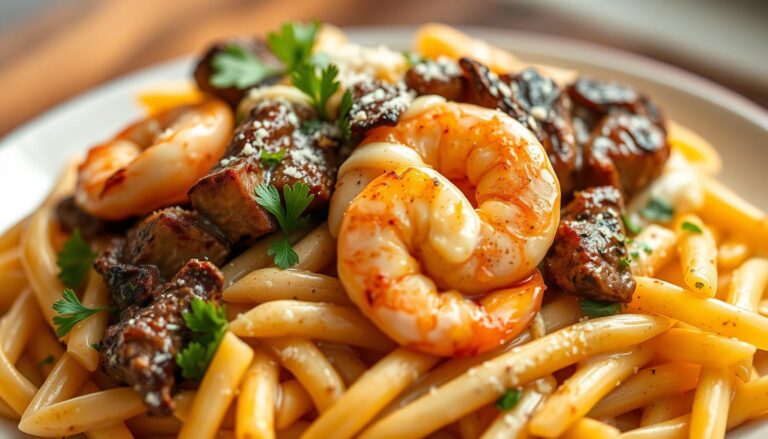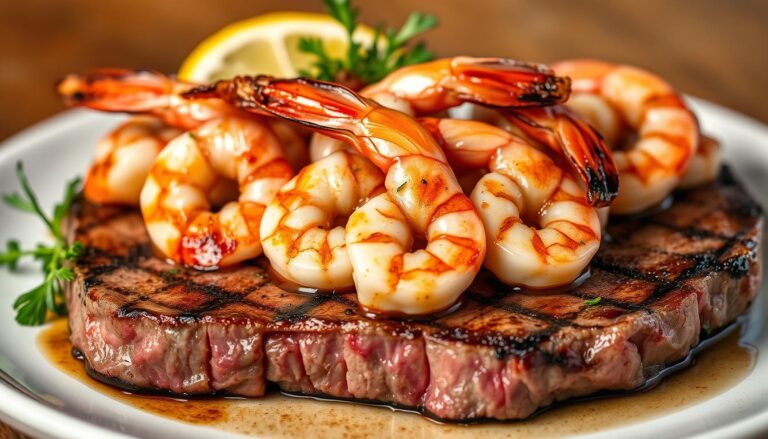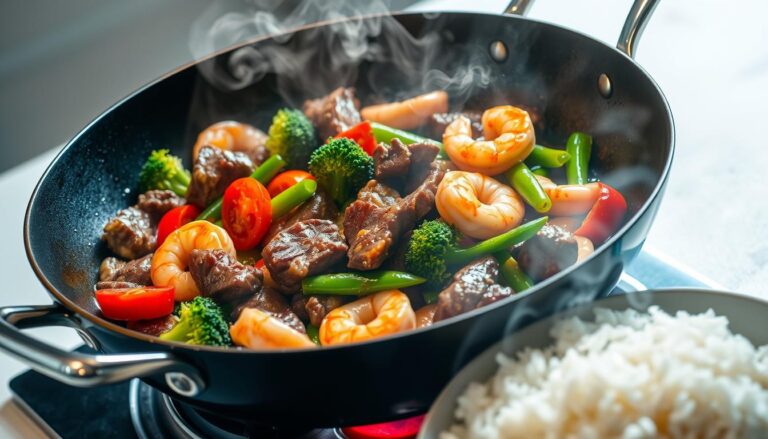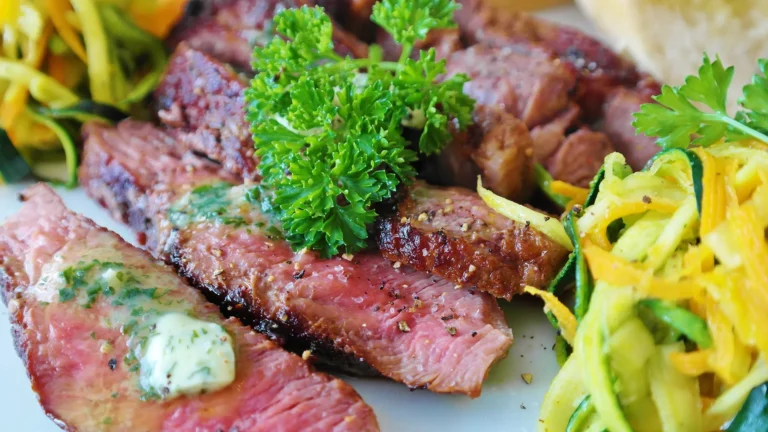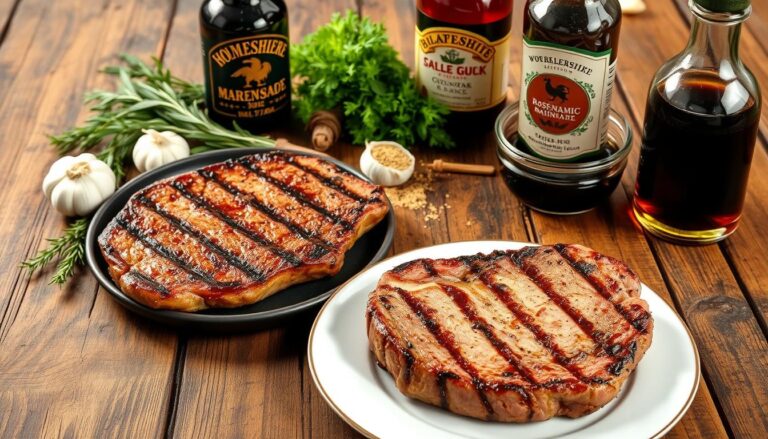Best Venison Marinade for Tender Grilled Venison
Table of Contents
Best Venison Marinade for Tender Grilled Venison
Grilling wild game can be tricky, but the right recipe makes all the difference. This flavorful marinade transforms tough cuts into juicy, tender steaks with minimal effort. Inspired by a hunter’s seven-year refinement, it balances acidity and umami for foolproof results.
The secret lies in simple ingredients like soy sauce and lime juice. Soy sauce naturally tenderizes the meat, while citrus adds brightness. A splash of Worcestershire sauce deepens the flavor, making it perfect for grilling.
Ready in 20 minutes, this mix works on pronghorn, duck, or rabbit too. Let it soak for at least one hour—though overnight delivers even better texture. Customize with smoked paprika or rosemary for a personal touch.
Key Takeaways
- Enhances tenderness with soy sauce’s enzymatic action
- Balances lime juice acidity and Worcestershire umami
- Works across wild game like venison and duck
- 20-minute prep with 1-hour minimum marination
- Grill-friendly for smoky, caramelized edges
Why This Venison Marinade Works
Understanding what makes this recipe effective helps you master wild game cooking. It combines food science and layered flavors to transform tough cuts into succulent meals.
The Science Behind Tenderizing Venison
Soy sauce contains proteolytic enzymes that soften muscle fibers. These enzymes break down proteins, making lean meat more tender. Acidic lime juice further enhances this process.
Worcestershire sauce adds depth with fermented anchovies and vinegar. Together, they create an umami-rich base. Salt penetrates the meat, locking in moisture during grilling.
Key Flavors in the Marinade
Balanced acidity and umami are the backbone. Citrus brightens the dish, while garlic and thyme add earthy notes. Customize heat with red pepper flakes or Tabasco.
For best results, marinate for at least 1–2 hours. Overnight soaking maximizes flavor and texture. This method works for all wild game, from elk to duck.
Ingredients You’ll Need
Every great recipe starts with quality components—this one is no exception. The right blend of pantry staples ensures tender, flavorful results. Below, we break down essentials and creative extras to tailor the dish to your taste.
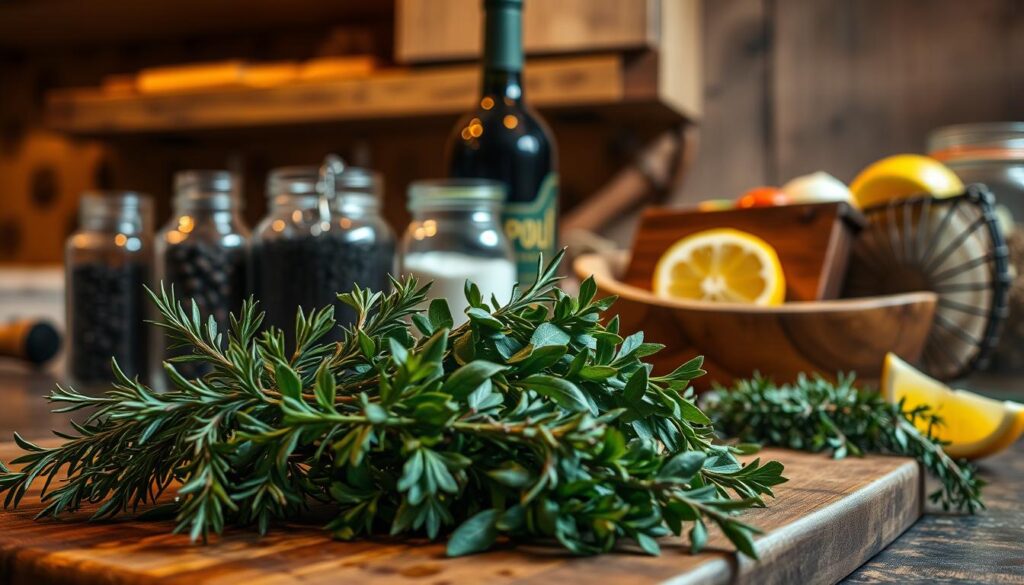
Essential Marinade Components
These foundational ingredients create the base flavor and tenderizing effect:
- Soy sauce (½ cup): Enzymatically softens meat while adding umami depth.
- Worcestershire sauce (¼ cup): Fermented tang enhances richness.
- Acid (¼ cup lime or lemon juice): Brightens flavors and aids tenderizing.
- Minced garlic (3 cloves): Fresh preferred, but ½ tsp powder works.
Optional Add-Ins for Extra Flavor
Customize with these boosts for regional or dietary preferences:
| Category | Options | Notes |
|---|---|---|
| Oils | Olive, canola | Use canola for high-heat grilling (smoke point: 400°F+) |
| Herbs | Rosemary, thyme | Fresh herbs add vibrancy; dried offer convenience |
| Heat | Red pepper flakes, Tabasco | Start with ½ tsp flakes or 1 tsp hot sauce |
| Sweeteners | Honey, brown sugar | Balances acidity; use 1 tbsp max |
For allergies, swap soy sauce with coconut aminos. Kosher salt (1 tsp) can replace table salt for cleaner seasoning. Experiment with smoked paprika or mushroom powder for earthy undertones.
Step-by-Step Marinade Preparation
Mastering the art of marinating starts with precise measurements and technique. Whether you’re a beginner or a seasoned cook, these directions ensure a flavorful result every time.
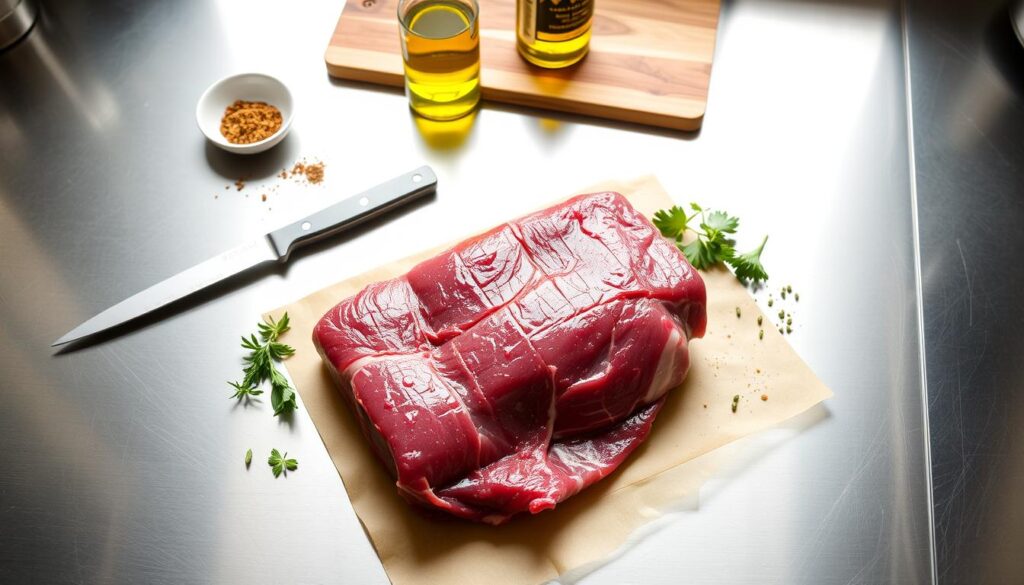
Mixing the Ingredients
Combine ½ cup soy sauce and ¼ cup Worcestershire sauce as the base. For acidity, add ¼ cup lime juice or swap with lemon for a milder taste. Whisk in 3 cloves of minced garlic and 1 teaspoon black pepper.
“Always taste your marinade before adding meat. Adjust salt or acidity with a tablespoon of honey if needed.”
Two mixing methods work well:
- Whisking: Ideal for emulsifying oils and acids in a bowl.
- Shaking: Use a jar or bag for easy cleanup and even coating.
Adjusting for Taste Preferences
Customize flavors based on your preferences. Add 1 tablespoon smoked paprika for depth or red pepper flakes for heat. Fresh herbs like thyme integrate best just before marinating.
For safety:
- Use glass containers or resealable bags to avoid leaks.
- Store in the fridge if marinating longer than 2 hours.
- Never reuse marinade that touched raw meat.
Double the recipe for future use—it keeps for 3 days refrigerated. Massage the marinade into the meat for even absorption, especially for thicker cuts.
How Long to Marinate Venison
Timing is everything when preparing wild game for the grill. Too little soaking leaves meat tough, while too long can ruin texture. Follow these guidelines to nail the perfect balance.
Minimum vs. Maximum Marinating Time
For thin cuts (1-inch thick), 1–2 hours is enough. Thicker steaks (2+ inches) need 4–24 hours for full flavor penetration. Enzymes in soy sauce work fastest in the first 4 hours.
| Cut Thickness | Minimum Time | Maximum Time |
|---|---|---|
| 1 inch | 1 hour | 4 hours |
| 2 inches | 4 hours | 24 hours |
“Partial freezing for 30 minutes before marinating helps fibers absorb flavors faster.”
Tips for Overnight Marination
For deeper flavor, refrigerate meat overnight. Keep temps at 34°F–40°F to prevent spoilage. Turn steaks every 3–4 hours for even coating.
- Vacuum-seal for 50% faster thawing and marinating.
- Use a baking soda rinse (1 tsp per cup of water) if meat feels mushy.
- Freshly field-dressed game needs less time than store-bought cuts.
Short on time? A 20-minute soak with a splash of pineapple juice can tenderize quickly. Always pat meat dry before grilling for better searing.
Grilling the Perfect Venison Steaks
The right grilling technique turns lean cuts into tender, flavorful masterpieces. Whether using gas or charcoal, proper heat management ensures juicy results without overcooking. Follow these steps for steakhouse-quality meals every time.
Preheating and Oiling the Grill
Start by preheating your grill to medium-high heat (400–450°F). This sears the meat, locking in juices. For charcoal, wait until coals are ash-covered. Gas users should heat for 10–15 minutes with the lid closed.
Oil the grates to prevent sticking. Use a folded paper towel dipped in olive oil and tongs to coat them. Avoid spray oils—they can cause flare-ups. For extra flavor, rub steaks with a thin layer of oil before placing them on the grill.
Cooking Times and Temperature Guide
Cook steaks for 4–5 minutes per side for medium-rare (130–135°F). Thicker cuts may need 6–7 minutes. Use a two-zone fire: sear over direct heat, then finish on the cooler side to avoid burning.
| Doneness | Internal Temp | Appearance |
|---|---|---|
| Rare | 120–125°F | Bright red center |
| Medium-Rare | 130–135°F | Warm red center |
| Medium | 140–145°F | Pink throughout |
“Rest steaks for 5–10 minutes under foil. This redistributes juices for maximum tenderness.”
Trim excess fat to reduce flare-ups. For lean cuts like venison, wrap with bacon to enhance moisture. Check temperature at the thickest part—avoid touching bones for accurate readings.
Variations and Pro Tips
Elevate your wild game cooking with these versatile twists and expert tips. Whether accommodating dietary restrictions or planning a complete meal, these adaptations ensure delicious results.
Alternative Ingredients for Dietary Needs
Simple swaps make this recipe work for nearly any eating plan. Try these tested modifications:
- Paleo/Whole30: Use coconut aminos instead of soy sauce and apple cider vinegar for acidity
- Low-sodium: Reduce soy sauce by half and add 1 tbsp mushroom powder for umami
- Smoky depth: Add ½ tsp chipotle powder with the garlic
- Wine infusion: Replace ¼ cup acid with dry red wine (add 1 tsp olive oil)
“For gluten-free needs, tamari works better than liquid aminos—it has richer flavor.”
Pairing Suggestions for Side Dishes
Complement your grilled meat with these seasonal side options:
| Season | Starches | Vegetables |
|---|---|---|
| Summer | Grilled cornbread | Charred zucchini |
| Fall | Wild rice pilaf | Roasted squash |
| Winter | Garlic mashed potatoes | Braised greens |
For sauces, reduce leftover marinade with 1 tbsp butter (boil first for safety). Serve with grilled asparagus—5 minutes on high heat keeps it crisp.
Expert-Level Tips
- Massage kosher salt into meat 1 hour before marinating for deeper seasoning
- Add cracked pepper after grilling to preserve its aroma
- Pair with bold red wines or amber ale—the maltiness balances gamey notes
- Use leftovers in tacos with pickled onions or steak salads with bitter greens
These recipes adapt beautifully to different wild game types. Experiment with a bit less marinating time for rabbit or quail.
Conclusion
Perfecting wild game starts with science and patience. The soy-lime blend breaks down tough fibers, while 4 hours of marination hits the sweet spot for flavor and tenderness. Always refrigerate raw meat and discard used mixtures to stay safe.
Grilling locks in juices better than other methods. Sear over high heat for caramelized edges. Customize with herbs or heat—this recipe adapts to your taste.
Share your twist on social media! Sustainable hunting and smart prep make every bite count. For more wild game tips, check our upcoming grill guides.
FAQ
How long should I soak the meat before cooking?
Can I use this recipe for other cuts like roasts or chops?
What’s the best way to store leftovers?
Do I need to remove the fat before soaking?
Can I substitute soy sauce if I’m avoiding gluten?
What sides pair well with grilled game meat?
Is olive oil necessary, or can I use another oil?
How do I prevent the steaks from drying out on the grill?
For more cooking tips, stay connected with us. We also recommend the cookbook Skinnytaste Simple: Easy, Healthy Recipes with 7 Ingredients or Fewer
For more Recipes about Steak ?


